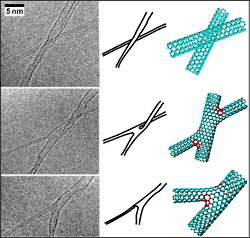 |
Getting the nanoplumbers in
It had to happen - an international team of researchers has developed a technique for welding together single-walled carbon nanotubes, which could pave the way to controlled fabrication of molecular circuits and nanotube networks.
Pulickel Ajayan and colleagues at the Rensselaer Polytechnic Institute in Troy, New York, working with colleagues in Germany, Mexico, the UK and Belgium, have used irradiation and heat to produce welded junctions between the all-carbon nanotubes, known colloquially as buckytubes. This is the first time single-walled nanotubes have been welded together, although multi-walled nanotubes with junctions have been previously created using growth techniques. Single-walled nanotubes have much more promise as possible nanoscale devices. "No one knew if junctions could be created," explains Ajayan. "Single-walled carbon nanotubes are perfect cylinders without any defects, but to create junctions between them, inter-tube carbon-carbon bonds need to form. The irradiation and heating process we use creates just enough defects for these bonds to form without damaging their electrical properties."
| |
 |
| Click image to magnify |
The team has spent several years working towards producing nanotubes that cross and touch that could then be welded together. "Unfortunately, we can't control this type of alignment just yet," Ajayan adds. However, using the high-energy transmission electron microscope located at the Max-Planck-Institute in Stuttgart the team has found that they can irradiate those tubes that serendipitously cross and touch and produce enough localized heat to fuse the tubes. Ajayan suggested to Reactive Reports that welded nanotubes might have electronic device applications as there have been many predictions on the usefulness of T- or Y- junctions with single-walled nanotubes, he told. He added that they might also form mechanically robust two-dimensional nanotube films or three-dimensional flexible nanotube architectures for coatings, conductive films, and other uses, or perhaps for robust cross-bar membranes.
|
|
 |
|

